AMD and Intel Mobile Rematch: Gateway NV5933u vs. Acer 5542
by Jarred Walton on June 18, 2010 1:14 AM ESTGraphics Performance Compared
First, let's get this out of the way: current IGP solutions (outside of the G320M in the latest MacBook) are weak contenders in terms of graphics performance. NVIDIA's old 9400M was already about 50% faster than the AMD HD 4200, and the G320M tripled the number of CUDA cores to provide the most potent IGP we've ever seen. Sadly, NVIDIA's IGP are now stuck in the position of only working with an outdated platform. Given Core 2 CPU performance is still more than fast enough for most users, we'd be interested in seeing non-Apple laptops use the G320M chipset as well, but that doesn't seem likely.
As far as the HD 4200 and Intel HD Graphics in our two test laptops, their performance characteristics are interesting to say the least. When we first played around with Intel's HD Graphics on a notebook, quite a few of the games we tested failed to run properly. Mass Effect 1/2 had major graphics corruption, GRID and DiRT 2 played the intro movies but then showed a black screen, Fallout 3 and Oblivion crashed when we tried to enter the game world (but worked in the menus), Battlefield Bad Company 2 also crashed when we tried to start a game, and the Unigine tests also had some issues. During the last few driver releases, we've seen nearly all of these issues fixed. As for Fallout 3, a hacked D3D.dll that identifies the GPU as something other than Intel graphics is all that's needed—Bethesda apparently hard-coded in a "don't run on Intel" command. That's not to say all games work properly—Bad Company 2 is still a known issue that Intel is working to address—but it's far more than we've experienced in the past from Intel graphics driver team.
For our graphics tests, we first ran a larger selection of games at minimum detail and 800x600 to see how the two platforms handle "reasonable" settings. Where appropriate, we've also included results from the old HD 3200 and GMA 4500MHD laptops to show how things have changed. We'll also show 3DMark results, though we again place far more emphasis on the games than on synthetic benchmarks. On the next page, we'll put graphics performance in perspective by comparing these IGPs with a variety of other laptops at the native 1366x768 LCD resolution.
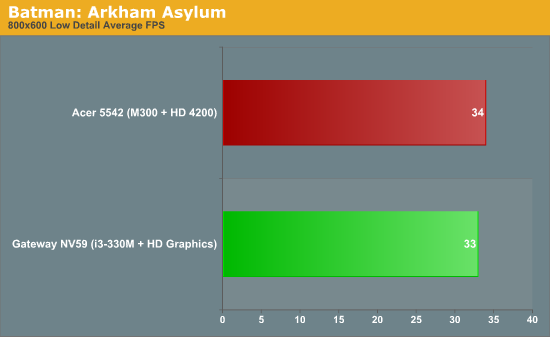
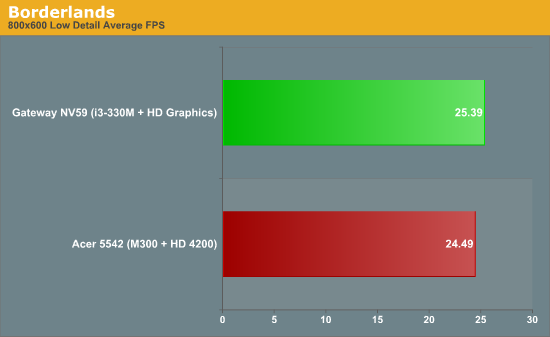
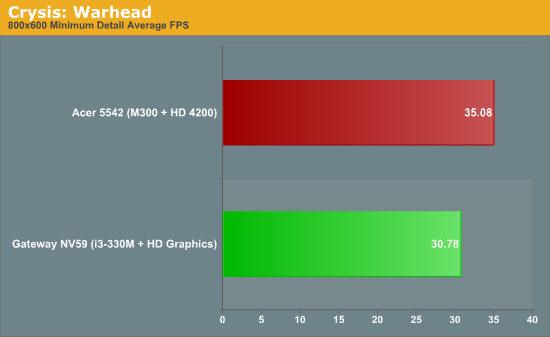
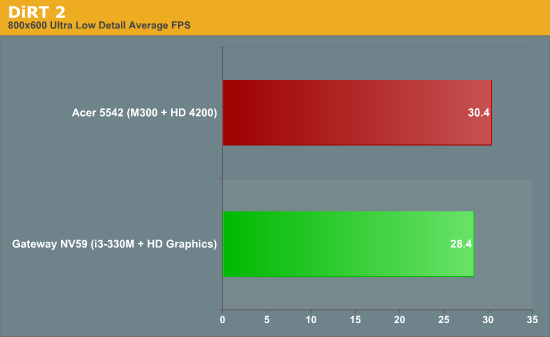
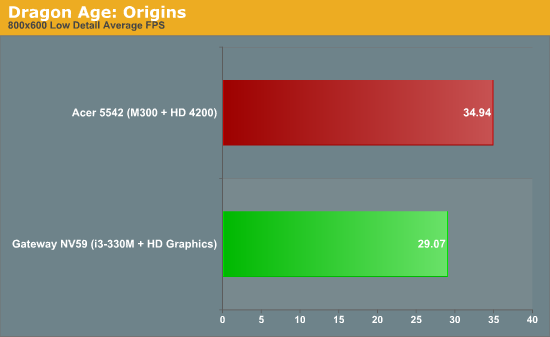
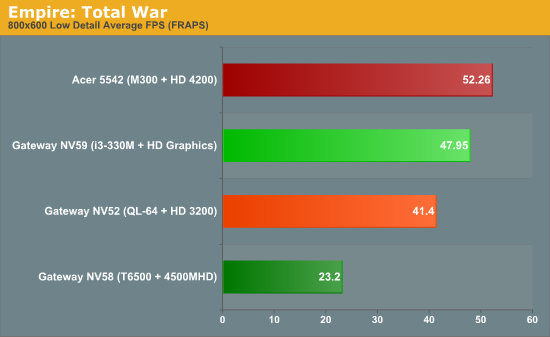
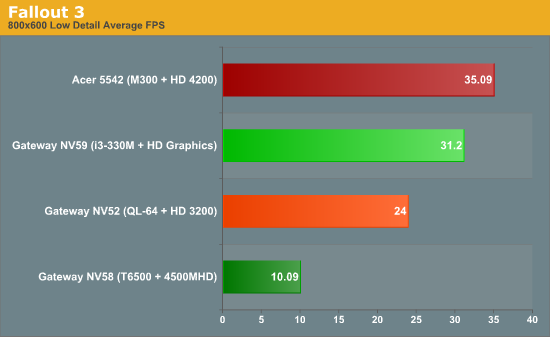
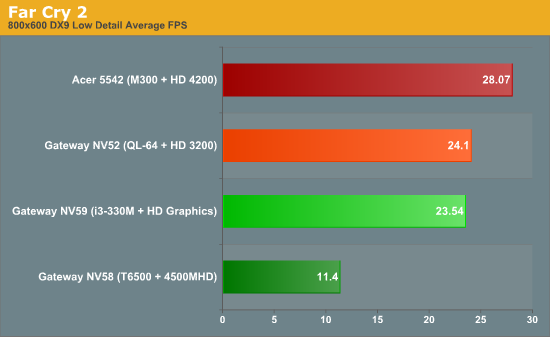
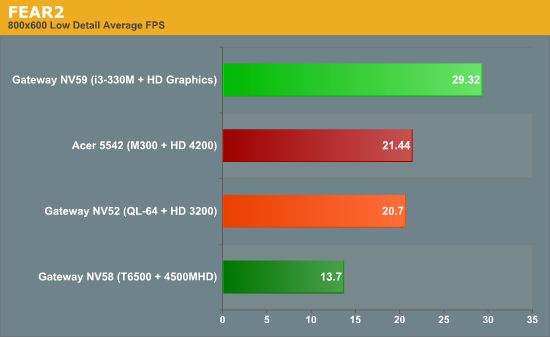
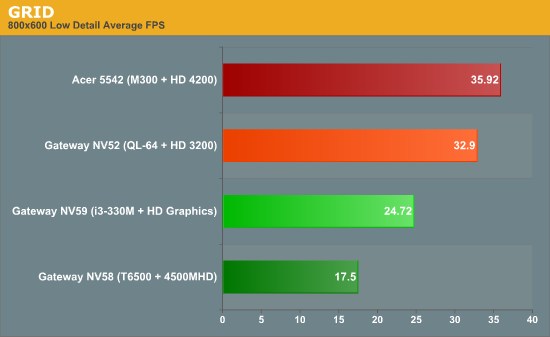


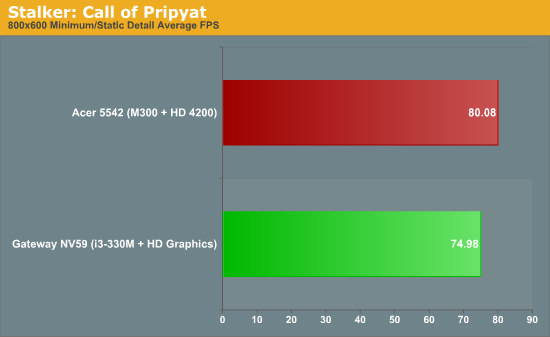
At our minimum performance settings, AMD's HD 4200 leads in most titles by anywhere from 3% to 20%. There are a couple titles where Intel HD Graphics takes the lead, however: 3% in Borderlands, and a very large 37% lead in FEAR 2. We're not talking about stellar performance in any of the games, but nearly all of the titles are at least playable in a pinch. The exception (not shown above) is Battlefield: Bad Company 2, which failed to run on the NV59 with the latest drivers. It requires a minimum resolution of 1024x768, and while it worked on the 5542, performance was dismal (around 13FPS). That's the good news: gaming is possible, and if you stick with pre-2008 titles you can find plenty of games that will run acceptably. The bad news is that in most cases you won't be running at native resolution, which is something the GeForce 9400M could at least manage. Note also, as one reader pointed out, that the i3 mobile processors run the IGP at 667MHz max, while the i5 series bumps that up to 766MHz; that 15% increase in clock would close the gap in many of the game results, though HD 4270 would likewise improve performance with its 590MHz clock.
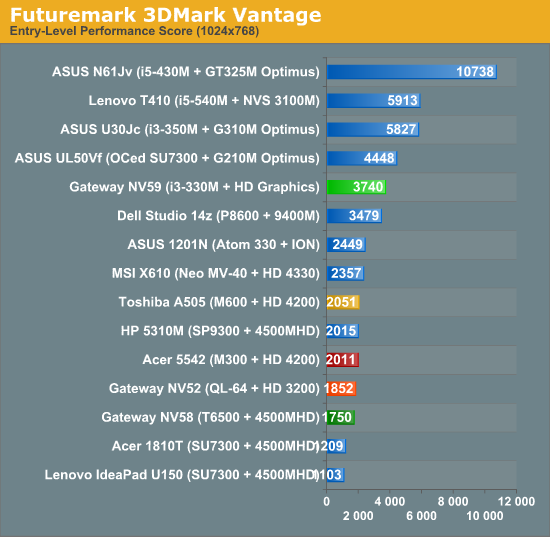
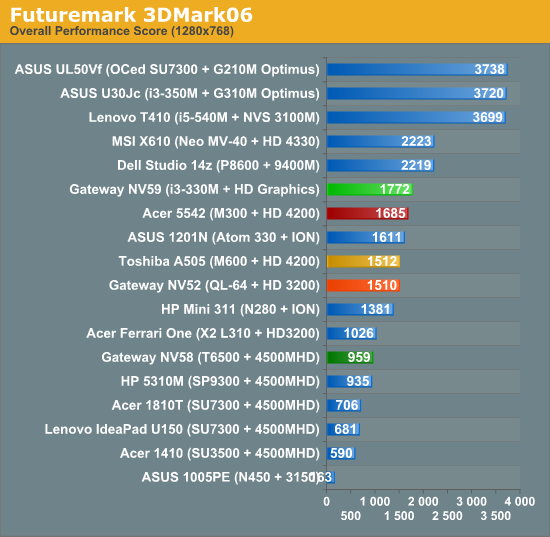
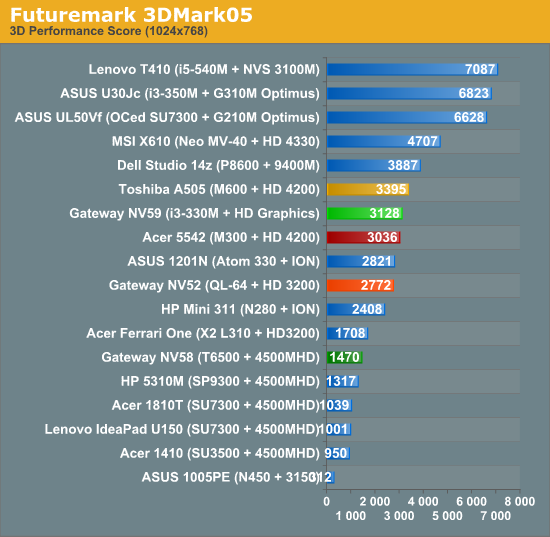
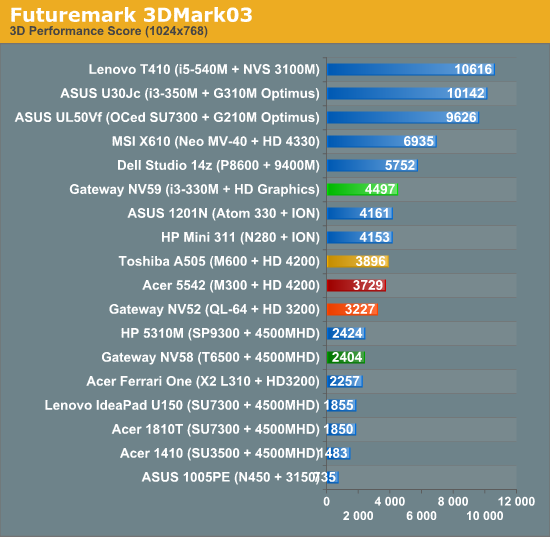
As for 3DMark, the Intel platform leads in all four versions. 3DMark05/06 are in a dead heat, 03 gives Intel a 21% lead, and Vantage delivers a theoretical 86% lead. We find that last a questionable result, and it indicates that Intel may have spent more time working on 3DMark optimizations than on actual gaming compatibility and performance. Ultimately, we don't really care too much about 3DMark performance, regardless of which version you want to run. Some users might like competing for top ORB results, but you're not going to come anywhere near the leader board with any notebook. So let's look at performance at native LCD resolution next, compared with a larger selection of laptops.










38 Comments
View All Comments
mojtabaalemi - Saturday, June 19, 2010 - link
I meaned 1005p with 11hrs (6cells, 48W/h) battery nor 3cell .could you please say what player you use with coreavc ? WMP ?
I read that wmp12 in win 7 can play 720p x264 on atom 1.66GHz beacuse of its multithread codeks . is it right?
mojtaba alemi from iran
JarredWalton - Saturday, June 19, 2010 - link
I used Media Player Classic Home Cinema in my more recent testing. I think I tried WMP11 in the past and it worked as well (maybe?), but I don't think I've ever tested with WMP12 and x264. I don't have any Atom laptops right now either, so I can't retest. :-|IntelUser2000 - Friday, June 18, 2010 - link
No, that's because 3DMark Vantage uses the retarded scheme where it includes the CPU scores as part of the final score. 3DMark06 was barely acceptable as a gaming benchmark because it started that, Vantage makes it worse.
JarredWalton - Friday, June 18, 2010 - link
Yes, it includes CPU performance as well, but you'll notice that nowhere in our CPU specific tests do we get 86%. In heavily threaded testing, we can achieve a 76% performance increase, but that's purely CPU based. Vantage includes CPU performance, but it's not as big of a factor as the GPU. 3DMark06 also includes CPU but shows only a 5% lead, which is more realistic.IntelUser2000 - Friday, June 18, 2010 - link
You should test this out if you have the chance/time.The 3 reasons that it has such a vast lead from greatest to smallest
1. 3DMark Vantage scores=GPU score(which is affected by the CPU like in real games) + CPU score
2. Some some CPU offloading(Never seen the game do that on the HD Graphics though)*
3. DX10 behavior on Intel is kinda like Nvidia. There's less loss from DX9 to DX10 code than on AMD.
*You can test this out by using the graphics control panel and going from Application(hardware mode) and Software Processing(software mode)
OldPueblo - Friday, June 18, 2010 - link
I just picked up a similar tigris laptop, except it had better specs and was only $380. At that price, I don't care if the Intel one wins because I doubt it'll ever compete at that price point. :) I didn't even bother with a warranty, it's disposable basic gaming on the go.M320 (2x2.1Ghz)
3GB RAM
250GB 7200RPM
Radeon 4200
802.11 B/G/N
8x DVD burner w/ lightscribe
5-in-1 card reader
etc.
OldPueblo - Monday, June 21, 2010 - link
Damnit! >:(http://www.frys-electronics-ads.com/ads/2010/06/18...
JarredWalton - Monday, June 21, 2010 - link
What size battery is in that? Probably a 48Wh, but I'm curious. Looking directly at Frys, I can't find the laptop listed above. What's the exact Lenovo model? I'm guessing it's the G555, but with some downgrades relative to the Lenovo store model. But yeah, $330 it can break in a year and you still won't care much.Roland00 - Monday, June 21, 2010 - link
It is a G555, I can't tell you which exact submodel it is, but the chasis/generation model is G555Roland00 - Friday, June 18, 2010 - link
I know you are at the mercy of what OEM sent you (since you don't want to spend $1000 to $2000 buying hardware for a simple article), but please try to get some of these AMD processors for these are going to be the more competitive AMDs (and more relevant).Note all these processors have hardware virtualization unlike the atoms and some of the intel culvs/core 2 offerings. Also note that none of the current AMD mobile processors offer l3 cache
Nile platform (2010) 9W, 12W, 15W with DDR3 support. All these processors are Champlain processors
9W, AMD V105, Single Core*1.2 Ghz, 512 kb L2 cache total
12W, AMD K125, Single Core*1.7 Ghz, 1 mb L2 cache total
12W, AMD K325, Dual Core*1.3 Ghz, 1 mb L2 cache per core, 2mb total
15W, AMD K625, Dual Core*1.5 Ghz, 1 mb L2 cache per core, 2mb total
15W, AMD K665, Dual Core*1.7 Ghz, 1 mb L2 cache per core, 2mb total
Danube platform (2010) 25W, 35W, 45W with DDR3 support. All these processors are Champlain processors
25W, AMD P820, Tri Core*1.8 Ghz, 512kb L2 cache per core, 1.5 mb total
25W, AMD P920, Quad Core*1.6 Ghz, 512kb L2 cache per core, 2 mb total
35W, AMD N620, Dual Core*2.8 Ghz, 1mb L2 cache per core, 2 mb total
35W, AMD N830, Tri Core*2.1 Ghz, 512 kb L2 cache per core, 1.5mb total
35W, AMD N930, Quad Core*2.0 Ghz, 512 kb L2 cache per core, 2mb total
45W, AMD X620BE, Dual Core*3.1 Ghz, 1mb L2 cache per core, 2mb total
45W, AMD X920BE, Quad Core*2.3 Ghz, 512 kb L2 cache per core, 2mb total
While the instructions per clock per core is not going to change much with the
Champlain processors (Mid 2010 with DDR3 uses K,P, or N monikers) vs
Caspain processors (Late 2009 with DDR2 uses M moniker, the dual cores come only in 35w tdps).
The Champlain processors achieve lower tdps, have ddr3 support or have more cores for the same tdp with ddr3 support when compared to the Caspain processors. I did not list the other new Champlain processors (the "value" models) for performance wise they should be similar to the one you demoed today (P520, N530, P320, N330). We won't get processors with more instructions per clock per core until the upcoming Llano (fusion, phenom II based with 1mb l2 cache per core, 10watts and above) and Ontario (fusion, bobcat based, 1-10watts aimed for netbooks, tablets, and other low power devices) . AMD finally has a competitive line of notebook processors on paper, for low tdps they may have something as good or almost as good as intel culv, at higher tdps they may not have as many instructions per clock as intel but then they are fighting that with more cores, or against the i7 720qm an extremly lower tdp.
(finally I just want to say that I am not an AMD fanboy, the last 4 processors I have bought have been intel. I7 920, Q6600, SU2300 Notebook, T7700 Notebook)